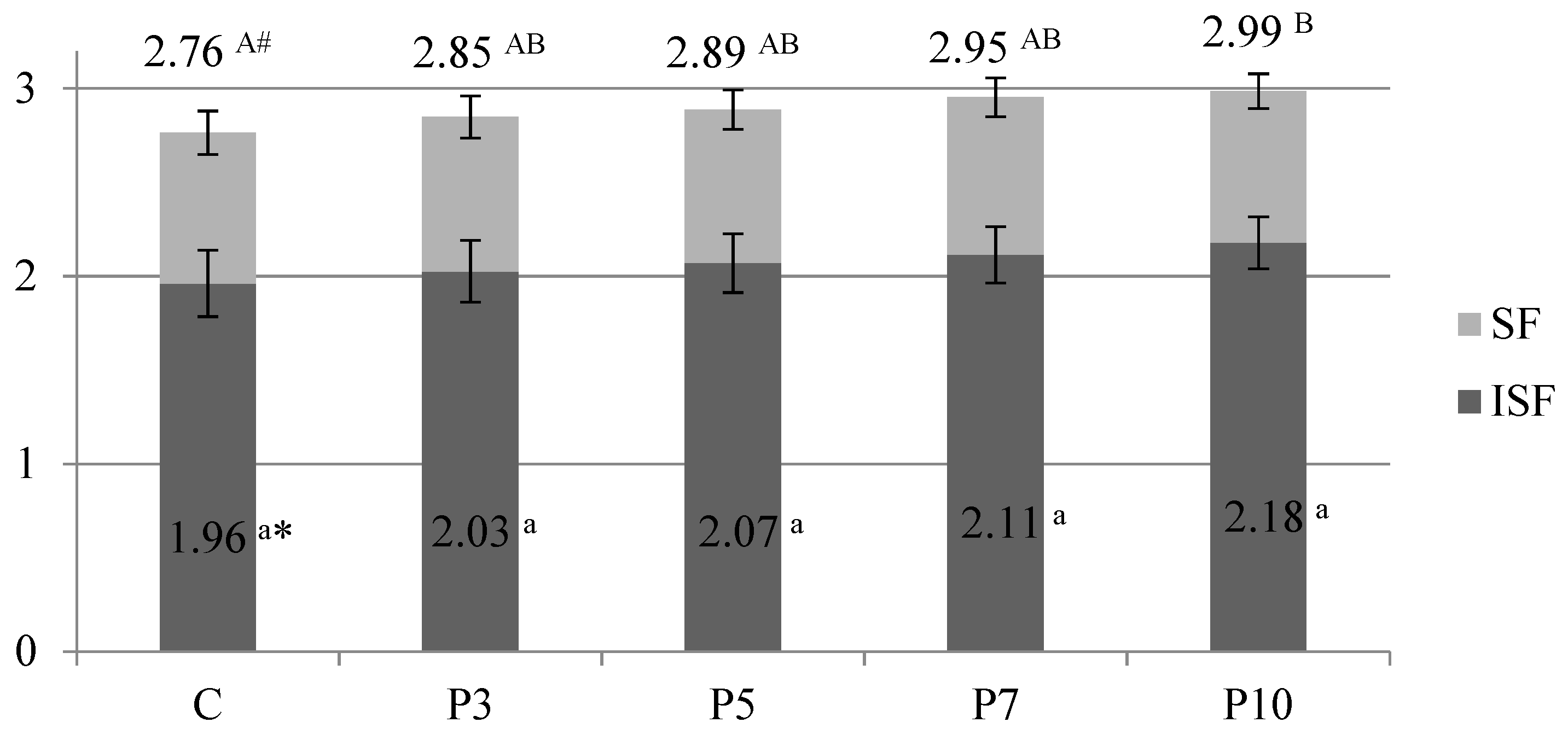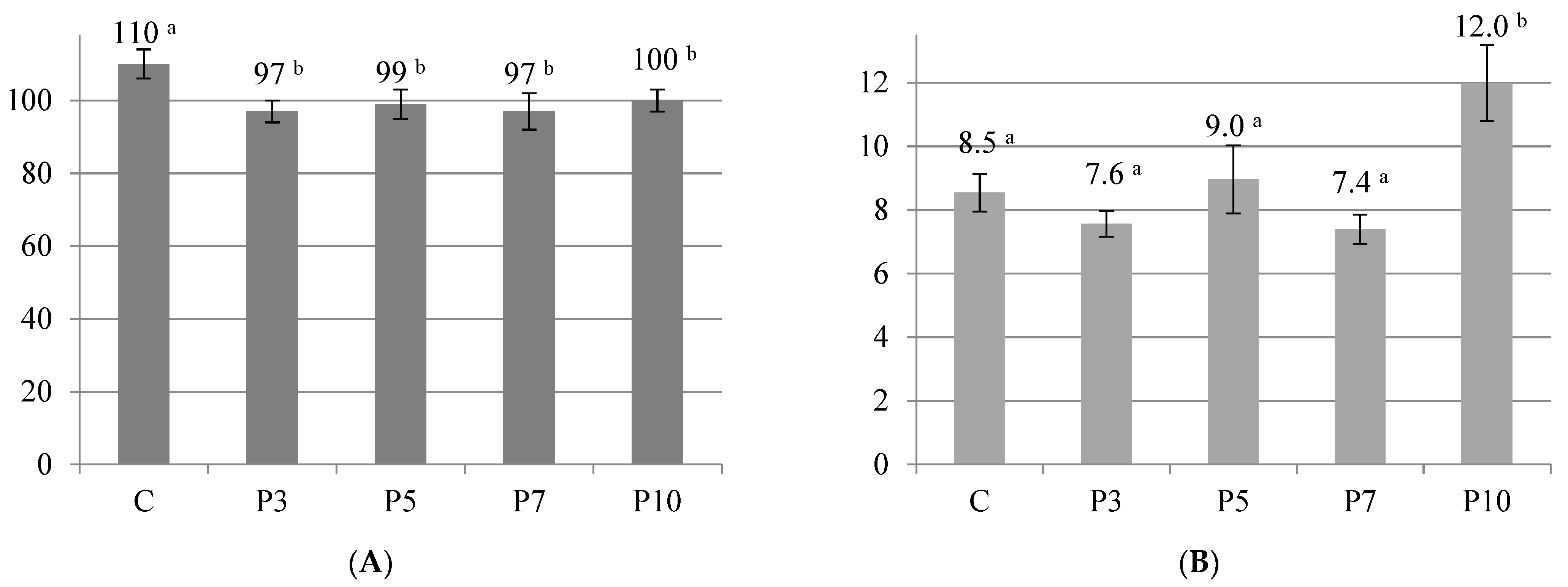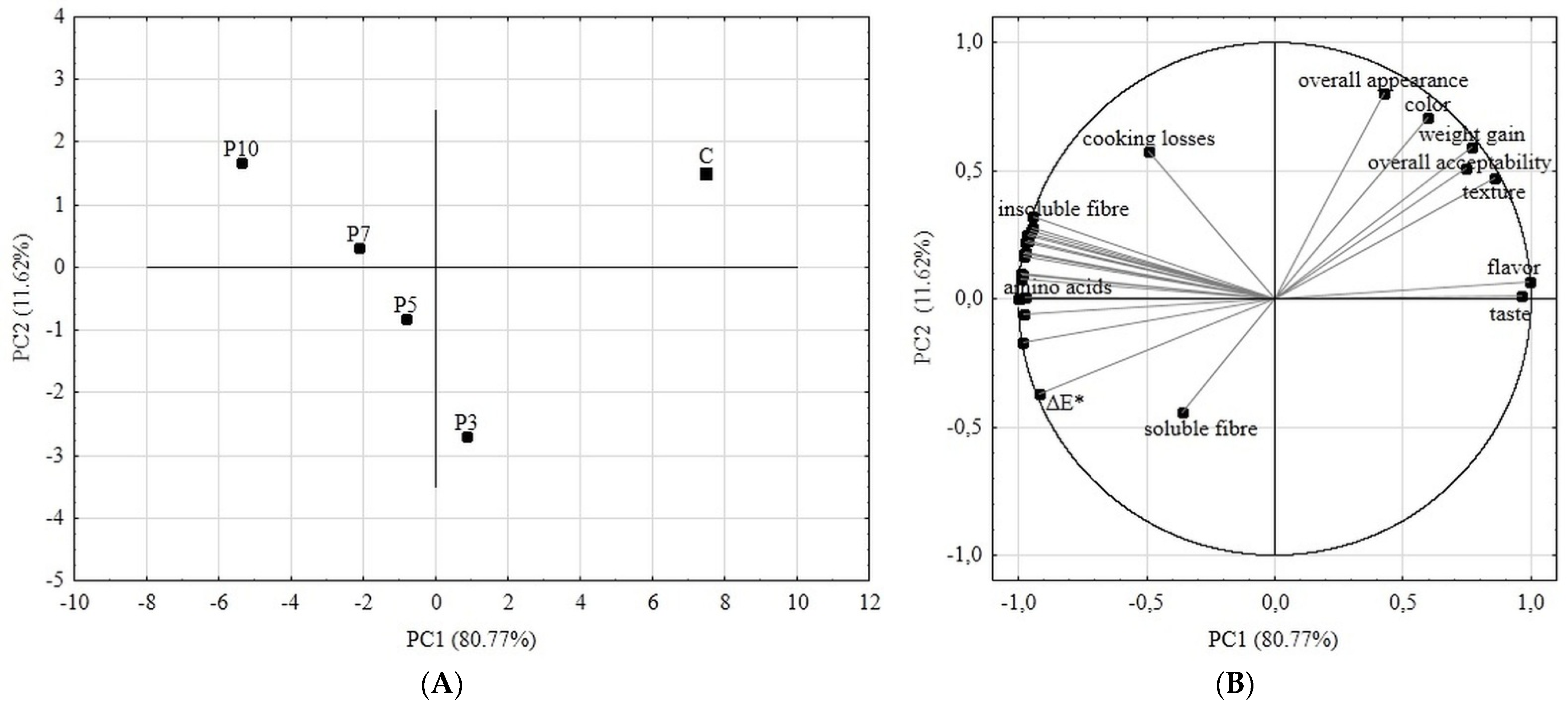Effect of Spirulina (Arthrospira platensis) Supplementation on Physical and Chemical Properties of Semolina (Triticum durum) Based Fresh Pasta
Abstract
:1. Introduction
2. Results and Discussion
2.1. Characteristics of the Semolina Flour and Spirulina Powder
2.2. Dietary Fiber Evaluation
2.3. Physicochemical Characteristics and Cooking Properties of Pasta
2.4. Amino Acids and Fatty Acids Evaluation
2.5. Sensory Characteristics of Pastas
2.6. The Comprehensive Overview of Obtained Pastas Characteristics
3. Materials and Methods
3.1. Chemicals
3.2. Preparation of Pastas
3.3. Weight Gain and Swelling Index after Cooking
3.4. Cooking Losses
3.5. Moisture and Ash Determination
3.6. Determination of Proximal Nutritional and Energy Values
3.7. Amino Acids Determination
3.8. Color Determination of Pastas Dough
3.9. Fatty Acid Composition
3.10. Sensory Evaluation of Fresh Pastas
3.11. Calculations and Statistics
4. Conclusions
Author Contributions
Funding
Institutional Review Board Statement
Informed Consent Statement
Data Availability Statement
Acknowledgments
Conflicts of Interest
Sample Availability
References
- Pagani, M.A.; Lucisano, M.; Mariotti, M. Traditional Italian Products from Wheat and Other Starchy Flours. In Handbook of Food Products Manufacturing; Hui, Y.H., Ed.; John Wiley & Sons: Hoboken, NJ, USA, 2006; pp. 327–388. [Google Scholar]
- Machu, L.; Misurcova, L.; Ambrozova, J.V.; Orsavova, J.; Mlcek, J.; Sochor, J.; Jurikova, T. Phenolic Content and Antioxidant Capacity in Algal Food Products. Molecules 2015, 20, 1118–1133. [Google Scholar] [CrossRef] [PubMed] [Green Version]
- Fradinho, P.; Niccolai, A.; Soares, R.; Rodolfi, L.; Biondi, N.; Tredici, M.R.; Sousa, I.; Raymundo, A. Effect of Arthrospira platensis (spirulina) incorporation on the rheological and bioactive properties of gluten-free fresh pasta. Algal Res. 2020, 45, 101743. [Google Scholar] [CrossRef]
- Oladunmoye, O.O.; Aworh, O.C.; Maziya-Dixon, B.; Erukainure, O.L.; Elemo, G.N. Chemical and functional properties of cassava starch, durum wheat semolina flour, and their blends. Food Sci. Nutr. 2014, 2, 132–138. [Google Scholar] [CrossRef] [PubMed]
- Pauly, A.; Pareyt, B.; Fierens, E.; Delcour, J.A. Wheat (Triticum aestivumL. andT. turgidumL. ssp.durum) Kernel Hardness: II. Implications for End-Product Quality and Role of Puroindolines Therein. Compr. Rev. Food Sci. Food Saf. 2013, 12, 427–438. [Google Scholar] [CrossRef]
- Troccoli, A.; Borrelli, G.M.; De Vita, P.; Fares, C.; Di Fonzo, N. Mini Review: Durum Wheat Quality: A Multidisciplinary Concept. J. Cereal Sci. 2000, 32, 99–113. [Google Scholar] [CrossRef]
- Filip, S.; Vidrih, R. Amino Acid Composition of Protein-Enriched Dried Pasta: Is It Suitable for a Low-Carb Diet? Food Technol. Biotechnol. 2015, 53, 298–306. [Google Scholar] [CrossRef]
- Wójtowicz, A.; Mościcki, L. Influence of legume type and addition level on quality characteristics, texture and microstructure of enriched precooked pasta. LWT Food Sci. Technol. 2014, 59, 1175–1185. [Google Scholar] [CrossRef]
- Ramya, N.S.; Prabhasankar, P.; Gowda, L.R.; Modi, V.K.; Bhaskar, N. Influence of Freeze-Dried Shrimp Meat in Pasta Processing Qualities of IndianT. durumWheat. J. Aquat. Food Prod. Technol. 2015, 24, 582–596. [Google Scholar] [CrossRef]
- Liu, T.; Hamid, N.; Kantono, K.; Pereira, L.; Farouk, M.; Knowles, S.O. Effects of meat addition on pasta structure, nutrition and in vitro digestibility. Food Chem. 2016, 213, 108–114. [Google Scholar] [CrossRef]
- Devi, N.L.; Aparna, K.; Kalpana, K. Utilization of fish mince in formulation and development of pasta products. Int. Food Res. J. 2013, 20, 219–224. [Google Scholar]
- Desai, A.; Brennan, M.A.; Brennan, C.S. The effect of semolina replacement with protein powder from fish (Pseudophycis bachus) on the physicochemical characteristics of pasta. LWT Food Sci. Technol. 2017, 89, 52–57. [Google Scholar] [CrossRef] [Green Version]
- Baskaran, D.; Muthupandian, K.; Gnanalakshmi, K.S.; Pugazenthi, T.R.; Jothylingam, S. Physical properties of noodles enriched with whey protein concentrate (WPC) and skim milk powder (SMP). J. Stored Prod. Postharvest Res. 2011, 2, 127–130. [Google Scholar]
- Lemes, A.C.; Takeuchi, K.P.; Carlos, J.; De Carvalho, M.; Dalva, E.; Danesi, G. Fresh Pasta Production Enriched with Spirulina platensis Biomass. Arch. Biol. Technol. 2012, 55, 741–750. [Google Scholar] [CrossRef]
- Shimamatsu, H. Mass production of Spirulina, an edible microalga. Hydrobiologia 2004, 512, 39–44. [Google Scholar] [CrossRef]
- Food and Agriculture Organization of the United Nations (FAO). Report of an FAQ Expert Consultation Dietary Protein Quality Evaluation in Human Nutrition; Food and Agriculture Organization of the United Nations (FAO): Rome, Italy, 2011; Volume 92. [Google Scholar]
- Gumbo, J.R.; Nesamvuni, C.N. A Review: Spirulina a source of bioactive compounds and nutrition. J. Chem. Pharm. Sci. 2017, 10, 1317–1325. [Google Scholar]
- Hasmadi, M. Effect of water on the caking properties of different types of wheat flour. Food Res. 2021, 5, 266–270. [Google Scholar] [CrossRef]
- Cardoso, R.V.C.; Fernandes, Â.; Heleno, S.A.; Rodrigues, P.; González-Paramás, A.M.; Barros, L.; Ferreira, I.C.F.R. Physicochemical characterization and microbiology of wheat and rye flours. Food Chem. 2019, 280, 123–129. [Google Scholar] [CrossRef] [Green Version]
- Morsy, O.M.; Sharoba, A.M.; EL-Desouky, A.I.; Bahlol, H.E.M.; El Mawla, E.M.A. Production and evaluation of some extruded food products using spirulina algae. Ann. Agric. Sci. Moshtohor 2014, 52, 495–510. [Google Scholar] [CrossRef]
- Saharan, V.; Jood, S. Nutritional Composition of Spirulina Platensis Powder and Its Acceptability in Food Products. Int. J. Adv. Res. 2017, 5, 2295–2300. [Google Scholar] [CrossRef] [Green Version]
- Ötles, S.; Ozgoz, S. Health effects of dietary fiber. Acta Sci. Pol. Technol. Aliment. 2014, 13, 191–202. [Google Scholar] [CrossRef]
- Fuller, S.; Beck, E.; Salman, H.; Tapsell, L. New Horizons for the Study of Dietary Fiber and Health: A Review. Plant Foods Hum. Nutr. 2016, 71, 1–12. [Google Scholar] [CrossRef]
- Dziki, D. Current Trends in Enrichment of Wheat Pasta: Quality, Nutritional Value and Antioxidant Properties. Processes 2021, 9, 1280. [Google Scholar] [CrossRef]
- Raczyk, M.; Kruszewski, B.; Michałowska, D. Effect of Coconut and Chestnut Flour Supplementations on Texture, Nutritional and Sensory Properties of Baked Wheat Based Bread. Molecules 2021, 26, 4641. [Google Scholar] [CrossRef] [PubMed]
- Saharan, V.; Jood, S. Effect of storage on Spirulina platensis powder supplemented breads. J. Food Sci. Technol. 2021, 58, 978–984. [Google Scholar] [CrossRef] [PubMed]
- del Moral, L.F.G.; Rharrabti, Y.; Martos, V.; Royo, C. Environmentally Induced Changes in Amino Acid Composition in the Grain of Durum Wheat Grown under Different Water and Temperature Regimes in a Mediterranean Environment. J. Agric. Food Chem. 2007, 55, 8144–8151. [Google Scholar] [CrossRef]
- Laze, A.; Arapi, V.; Ceca, E.; Gusho, K.; Pezo, L.; Brahushi, F.; Kneževic, D. Chemical Composition and Amino Acid Content in Different Genotypes of Wheat Flour. Period. Polytech. Chem. Eng. 2019, 63, 618–628. [Google Scholar] [CrossRef]
- Durante, M.; Lenucci, M.S.; Rescio, L.; Mita, G.; Caretto, S. Durum wheat by-products as natural sources of valuable nutrients. Phytochem. Rev. 2012, 11, 255–262. [Google Scholar] [CrossRef]
- Narducci, V.; Finotti, E.; Galli, V.; Carcea, M. Lipids and Fatty Acids in Italian Durum Wheat (Triticum durum Desf.) Cultivars. Foods 2019, 8, 223. [Google Scholar] [CrossRef] [Green Version]
- Park, W.S.; Kim, H.J.; Li, M.; Lim, D.H.; Kim, J.; Kwak, S.S.; Kang, C.M.; Ferruzzi, M.G.; Ahn, M.J. Two classes of pigments, carotenoids and c-phycocyanin, in spirulina powder and their antioxidant activities. Molecules 2018, 23, 2065. [Google Scholar] [CrossRef] [Green Version]
- Cleary, L.; Brennan, C. The influence of a (1→3)(1→4)-β-d-glucan rich fraction from barley on the physico-chemical properties and in vitro reducing sugars release of durum wheat pasta. Int. J. Food Sci. Technol. 2006, 41, 910–918. [Google Scholar] [CrossRef]
- American Association of Cereal Chemists (AACC). AACC Approved Methods of Analysis 11th Ed. Method 60-50. Pasta and Noodle Cooking Quality; AACC: Minnesota, MN, USA, 2010. [Google Scholar]
- American Association of Cereal Chemists (AACC). AACC Approved Methods of Analysis 11th Ed. Method 44-15.02. Moisture—Air-Oven Methods; AACC: Minnesota, MN, USA, 2010. [Google Scholar]
- American Association of Cereal Chemists (AACC). AACC Approved Methods of Analysis 11th Ed. Method 08-01.01. Ash—Basic Method; AACC: Minnesota, MN, USA, 2010. [Google Scholar]
- American Association of Cereal Chemists (AACC). AACC Approved Methods of Analysis 11th Ed. Method 46-11.02. Crude Protein—Improved Kjeldahl Method, Copper Catalyst Modification; AACC: Minnesota, MN, USA, 2010. [Google Scholar]
- López, C.V.G.; del García, M.C.C.; Fernandez, F.G.A.; Bustos, C.S.; Chisti, Y.; Sevilla, J.M.F. Protein measurements of microalgal and cyanobacterial biomass. Bioresour. Technol. 2010, 101, 7587–7591. [Google Scholar] [CrossRef]
- Ungureanu-Iuga, M.; Mironeasa, S. Advance on the Capitalization of Grape Peels By-Product in Common Wheat Pasta. Appl. Sci. 2021, 11, 11129. [Google Scholar] [CrossRef]
- AOAC INTERNATIONAL. AOAC Official Method 991.43 Total, Soluble, and Insoluble Dietary Fibre in Foods; AOAC: Rockville, MD, USA, 2000. [Google Scholar]
- American Association of Cereal Chemists (AACC). AACC Approved Methods of Analysis 11th Ed. Method 32-07.01. Soluble, Insoluble, and Total Dietary Fiber in Foods and Food Products; AACC: Minnesota, MN, USA, 2010. [Google Scholar]
- Kwanyuen, P.; Burton, J.W. A Modified Amino Acid Analysis Using PITC Derivatization for Soybeans with Accurate Determination of Cysteine and Half-Cystine. J. Am. Oil Chem. Soc. 2009, 87, 127–132. [Google Scholar] [CrossRef]
- Hawrot-Paw, M.; Ratomski, P.; Koniuszy, A.; Golimowski, W.; Teleszko, M.; Grygier, A. Fatty Acid Profile of Microalgal Oils as a Criterion for Selection of the Best Feedstock for Biodiesel Production. Energies 2021, 14, 7334. [Google Scholar] [CrossRef]
- International Organization for Standardization (ISO). ISO 6658:2017; Sensory Analysis—Methodology—General Guidance 2017. International Organization for Standardization (ISO): Geneva, Switzerland, 2017.
- Kruszewski, B.; Zawada, K.; Karpiński, P. Impact of High-Pressure Homogenization Parameters on Physicochemical Characteristics, Bioactive Compounds Content, and Antioxidant Capacity of Blackcurrant Juice. Molecules 2021, 26, 1802. [Google Scholar] [CrossRef]




| Spirulina Powder | Semolina Flour | |
|---|---|---|
| Moisture (%) | 7.09 ± 0.04 a | 12.91 ± 0.01 b |
| Protein | 71.34 ± 0.21 b | 11.88 ± 0.12 a |
| Fat | 0.36 ± 0.01 a | 1.26 ± 0.05 b |
| Ash | 5.93 ± 0.30 b | 1.12 ± 0.14 a |
| Carbohydrates | 6.83 ± 0.19 a | 68.39 ± 0.08 b |
| Insoluble dietary fiber | 6.46 ± 0.33 b | 3.07 ± 0.28 a |
| Soluble dietary fiber | 1.99 ± 0.14 a | 1.37 ± 0.20 a |
| Total dietary fiber | 8.45 ± 0.19 b | 4.44 ± 0.08 a |
| Energy value (kJ) | 1395.0 ± 0.9 a | 1427.9 ± 3.5 b |
| Energy value (kcal) | 333.4 ± 8.5 a | 341.3 ± 0.8 b |
| Color Values | C | P3 | P5 | P7 | P10 |
|---|---|---|---|---|---|
| L* | 75.26 ± 1.25 d | 40.18 ± 1.07 c | 35.22 ± 0.68 b | 32.56 ± 1.86 a | 32.01 ± 0.92 a |
| a* | 3.45 ± 1.01 d | −14.12 ± 0.56 a | −11.45 ± 0.18 b | −9.88 ± 0.74 c | −8.72 ± 0.39 c |
| b* | 27.83 ± 2.27 c | 7.21 ± 0.30 b | 5.90 ± 0.20 ab | 5.21 ± 0.45 a | 4.71 ± 0.25 a |
| ΔE* | - | 44.34 ± 0.76 a | 48.03 ± 0.56 b | 50.14 ± 1.58 c | 50.53 ± 0.80 c |
| Amino Acids | Spirulina Powder | Semolina Flour | Fatty Acids | Spirulina Powder | Semolina Flour |
|---|---|---|---|---|---|
| aspartic acid + asparagine | 30.69 ± 0.74 b | 7.79 ± 0.32 a | C14:0 | nd | 0.06 ± 0.01 |
| glutamic acid + glutamine | 49.63 ± 0.16 b | 40.16 ± 0.45 a | C15:0 | nd | 0.09 ± 0.03 |
| serine | 20.35 ± 0.04 b | 8.46 ± 0.47 a | C16:0 | 51.54 ± 2.26 b | 16.83 ± 0.49 a |
| glycine | 21.26 ± 0.32 b | 5.48 ± 0.00 a | C16:1 | 2.88 ± 1.57 b | 0.18 ± 0.05 a |
| histidine | 27.39 ± 0.25 b | 3.94 ± 0.14 a | C17:0 | 4.04 ± 0.13 b | 0.07 ± 0.00 a |
| arginine | 26.13 ± 0.44 b | 6.65 ± 0.05 a | C17:1 | nd | 0.26 ± 0.05 |
| threonine | 39.61 ± 0.13 b | 4.97 ± 0.00 a | C18:0 | 1.06 ± 0.28 a | 1.25 ± 0.07 a |
| alanine | 12.10 ± 0.27 b | 2.45 ± 0.09 a | C18:1 | 2.69 ± 0.26 a | 20.79 ± 0.40 b |
| proline | 22.92 ± 0.00 a | 31.90 ± 0.04 b | C18:2t | 1.30 ± 0.04 | nd |
| tyrosine | 20.34 ± 0.37 b | 7.16 ± 0.18 a | C18:2c | 17.21 ± 0.74 a | 56.02 ± 0.37 b |
| valine | 27.89 ± 0.52 b | 6.43 ± 0.23 a | C18:3 (n-3) | nd | 3.43 ± 0.10 |
| methionine | 8.07 ± 0.14 b | 2.01 ± 0.01 a | C18:3 (n-6) | 19.30 ± 0.59 | nd |
| cysteine | 4.60 ± 0.06 a | 5.49 ± 0.01 a | others | - | 1.05 ± 0.03 |
| isoleucine | 25.34 ± 0.40 b | 5.11 ± 0.38 a | Σ SFA | 56.63 ± 0.89 b | 18.46 ± 0.08 a |
| leucine | 39.69 ± 0.80 b | 8.49 ± 0.32 a | Σ MUFA | 5.57 ± 0.92 a | 22.06 ± 0.14 b |
| phenylalanine | 19.02 ± 0.72 b | 7.59 ± 0.33 a | Σ PUFA | 37.80 ± 0.76 a | 59.50 ± 0.16 b |
| lysine | 22.62 ± 0.01 b | 7.57 ± 0.42 a |
| Amino Acids | C | P3 | P5 | P7 | P10 |
|---|---|---|---|---|---|
| aspartic acid + asparagine | 7.17 ± 0.04 a | 9.61 ± 0.02 b | 13.21 ± 0.15 c | 14.81 ± 0.27 d | 18.99 ± 0.14 e |
| glutamic acid + glutamine | 28.95 ± 0.06 a | 33.87 ± 0.22 b | 40.38 ± 0.59 c | 43.95 ± 0.40 d | 48.18 ± 0.75 e |
| serine | 4.21 ± 0.02 a | 6.03 ± 0.06 b | 6.16 ± 0.20 b | 6.95 ± 0.20 bc | 8.05 ± 0.00 d |
| glycine | 2.68 ± 0.16 a | 3.79 ± 0.21 b | 4.15 ± 0.22 bc | 4.70 ± 0.19 cd | 5.22 ± 0.03 d |
| histidine | 0.71 ± 0.01 a | 2.97 ± 0.16 b | 2.96 ± 0.09 b | 3.27 ± 0.07 b | 4.05 ± 0.30 c |
| arginine | 3.03 ± 0.07 a | 4.59 ± 0.20 b | 4.91 ± 0.08 bc | 5.28 ± 0.05 c | 6.04 ± 0.21 d |
| threonine | 2.72 ± 0.03 a | 3.93 ± 0.14 b | 4.35 ± 0.08 c | 5.08 ± 0.13 d | 6.29 ± 0.10 e |
| alanine | 1.24 ± 0.00 a | 2.21 ± 0.01 b | 3.05 ± 0.15 c | 3.41 ± 0.05 d | 4.06 ± 0.08 e |
| proline | 10.35 ± 0.02 a | 13.99 ± 0.62 b | 18.87 ± 0.00 c | 20.55 ± 0.67 c | 23.59 ± 0.54 d |
| tyrosine | 2.58 ± 0.16 a | 4.11 ± 0.46 b | 3.91 ± 0.18 b | 4.48 ± 0.04 bc | 5.10 ± 0.06 c |
| valine | 3.76 ± 0.01 a | 5.44 ± 0.07 b | 6.56 ± 0.46 c | 6.98 ± 0.04 c | 7.25 ± 0.09 c |
| methionine | 1.42 ± 0.14 a | 2.37 ± 0.04 b | 2.39 ± 0.05 b | 2.79 ± 0.01 c | 3.47 ± 0.14 d |
| cysteine | 3.17 ± 0.07 a | 3.56 ± 0.02 b | 4.28 ± 0.10 c | 4.33 ± 0.01 c | 4.90 ± 0.11 b |
| isoleucine | 3.01 ± 0.03 a | 4.55 ± 0.40 b | 5.76 ± 0.16 c | 6.59 ± 0.01 d | 7.51 ± 0.14 e |
| leucine | 5.71 ± 0.25 a | 7.55 ± 0.14 b | 11.00 ± 0.70 c | 12.36 ± 0.21 cd | 14.11 ± 0.59 d |
| phenylalanine | 4.12 ± 0.09 a | 5.69 ± 0.07 b | 6.24 ± 0.21 b | 7.48 ± 0.21 c | 8.34 ± 0.11 d |
| lysine | 1.58 ± 0.11 a | 4.04 ± 0.38 b | 4.94 ± 0.10 c | 5.08 ± 0.07 c | 6.54 ± 0.19 d |
| Ingredient | C | P3 | P5 | P7 | P10 |
|---|---|---|---|---|---|
| Semolina flour | 64.0 | 62.1 | 60.8 | 59.5 | 57.6 |
| Spirulina powder | 0.0 | 1.9 | 3.2 | 4.5 | 6.4 |
| Water | 36.0 | 36.0 | 36.0 | 36.0 | 36.0 |
Publisher’s Note: MDPI stays neutral with regard to jurisdictional claims in published maps and institutional affiliations. |
© 2022 by the authors. Licensee MDPI, Basel, Switzerland. This article is an open access article distributed under the terms and conditions of the Creative Commons Attribution (CC BY) license (https://creativecommons.org/licenses/by/4.0/).
Share and Cite
Raczyk, M.; Polanowska, K.; Kruszewski, B.; Grygier, A.; Michałowska, D. Effect of Spirulina (Arthrospira platensis) Supplementation on Physical and Chemical Properties of Semolina (Triticum durum) Based Fresh Pasta. Molecules 2022, 27, 355. https://doi.org/10.3390/molecules27020355
Raczyk M, Polanowska K, Kruszewski B, Grygier A, Michałowska D. Effect of Spirulina (Arthrospira platensis) Supplementation on Physical and Chemical Properties of Semolina (Triticum durum) Based Fresh Pasta. Molecules. 2022; 27(2):355. https://doi.org/10.3390/molecules27020355
Chicago/Turabian StyleRaczyk, Marianna, Katarzyna Polanowska, Bartosz Kruszewski, Anna Grygier, and Dorota Michałowska. 2022. "Effect of Spirulina (Arthrospira platensis) Supplementation on Physical and Chemical Properties of Semolina (Triticum durum) Based Fresh Pasta" Molecules 27, no. 2: 355. https://doi.org/10.3390/molecules27020355
APA StyleRaczyk, M., Polanowska, K., Kruszewski, B., Grygier, A., & Michałowska, D. (2022). Effect of Spirulina (Arthrospira platensis) Supplementation on Physical and Chemical Properties of Semolina (Triticum durum) Based Fresh Pasta. Molecules, 27(2), 355. https://doi.org/10.3390/molecules27020355









